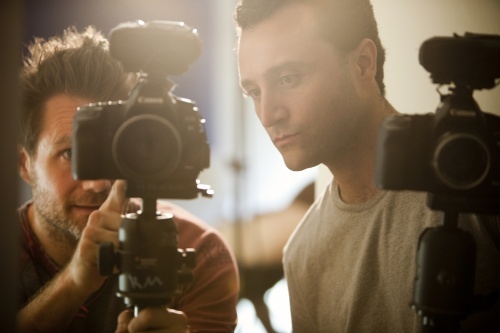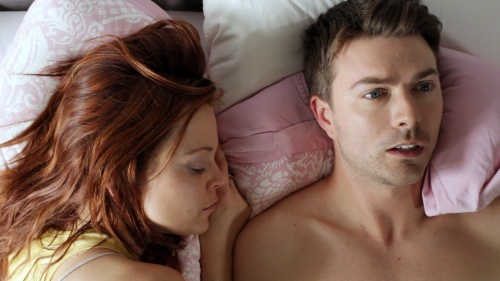

Less than five days after my award-winning NYC romantic comedy The Pill was released via the distributor FilmBuff on Cable Movies on Demand and on all the major VOD platforms including iTunes on February 28th 2012, it had worked its way up the iTunes rankings to the second most downloaded film in the Independent category. My movie has a modest production budget, has no traditional marketing campaign behind it, features no established movie stars (only great young actors), and was shot in 17 days with a small crew.
I will try to keep this blog as brief and straightforward as possible, because there is much to digest and discuss when it comes to the new world of DIY and micro budget filmmaking, but I think I can attribute this initial success of the film to two major factors that are out of my control and to two factors that are in my control.
The first of the two factors that were out of my control was the emergence of an inexpensive camera that captures beautiful, film quality images in 1080p HD – the Canon 5D. A lot has already been written on this camera by filmmakers better versed in the technical aspects of cinematography than myself, so I won't go into detail about how this one camera has revolutionized independent filmmaking. However, I will say that the camera alone isn't enough. If you want to capture truly filmic images that hold up when projected on a giant screen in a theater, then you need to use a good set of lenses. I used a set of Zeiss 1.4 ZE lenses including a 21mm, a 50mm, and an 85mm along with two Canon 5Ds that were shooting simultaneously. The lighting package was very sparse, and included an Arri light kit, a Kino Flo, and an LED light panel. I credit my director of photography Andreas von Scheele with pushing me to use good glass, the importance of which cannot be underestimated. And thanks to K&M Photo in Manhattan for providing the equipment.
The second factor that was out of my control was the emergence of a new digital distribution model. The old distribution model relied on expensive P&A (print and advertising) campaigns to try and get a film to perform in the theater and on DVD. This usually resulted in a loss, and a filmmaker would see no money off the back end since the distributor would have to recoup all their marketing expenses first. Enter digital distribution, which has very little up front marketing cost. Putting a film on VOD and Cable Movies on Demand is much less expensive than striking a print for a theater or pressing and manufacturing a DVD and box cover that then has to be shipped to brick and mortar stores. The digital distribution model is a boon for Independent filmmakers because it allows for films to be delivered directly to a viewer’s living room in HD. Getting butts in seats is much harder than bringing the seat the to proverbial butt. And thanks to social media, blogs, podcasts, reviews, etc. you can build awareness for your film economically and effectively. However, in order to compete with the studio film that has built in awareness thanks to a multi-million dollar marketing campaign, the indie film still has to deliver on the promise of being good, which leads me to two factors that are in my, and all filmmakers, control – story and performance.
The most important elements of making a film are the script and the actors. I didn’t want my film to turn into a producing exercise, so I wrote my script around locations I knew I had access to. In addition to working with an efficient and smart producer like Trevor Herrick, I kept the locations to a minimum, the cast size to a minimum, and I wrote about something that I knew – being single and dating in New York City. And most importantly, I made sure my characters felt real and honest. I wanted to create and mine awkward social situations for nuggets of human pathos and humor, and do so with truth and integrity – something most studio romantic comedies fail to do. I had never seen a film tackle the direct, morning-after consequences of a sexual interlude. If a mainstream film used a sex scene as a plot point, it would usually culminate with the female character informing the male character six weeks later that she was pregnant. Film had never explored the very human and universal morning-after “uh oh” scare. So, I decided it was time to change this and make a movie about a subject that has been virtually untapped.
The situations and characters in my film were mostly drawn from people I have closely observed and from my reservoir of personal knowledge. The result is something that audiences have found to be dramatic, real, and funny. I never tried to force a laugh or write a “funny line.” I just observed characters from real life, wrote them into my script, and dropped them into awkward social situations where they would have to make choices under pressure and clash, cajole, seduce, and bargain with one another in an organic fashion. Once I had a script that was unique and fresh, I had the confidence to seek out the best possible actors including Noah Bean, Rachel Boston, Anna Chlumsky, Al Thompson, Jean Brassard, Lué McWilliams, Rob Yang, and Dreama Walker and it was time to go and make the movie.
- J.C. Khoury, @ThePill_Movie
The Pill won numerous best film and acting awards on the festival circuit including the Audience Award from the Gen Art Film Festival. It is currently available in 45 million homes on Cable Movies on Demand and on all the major VOD platforms including iTunes.



